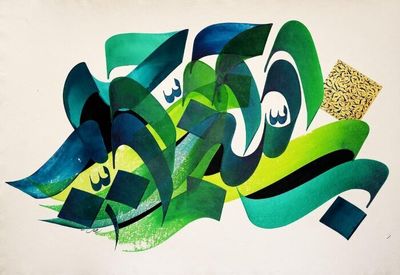The two calligraphers have teamed up to display their latest works available on the web site gallery.irunesco.org.
Speaking at the opening ceremony inaugurated last week, the Iranian National Commission for UNESCO director Hojjatollah Ayyubi called Iran the cradle of calligraphy.
Ayyubi further noted that the idea that the Silk Road not only is a commercial route, but also a road to exchange thoughts, was discussed earlier during a cultural exhibition in Hamedan in September 2019 at the 6th meeting of the Coordinating Committee on the Serial Transnational World Heritage Nomination of the Silk Road.
“We decided to hold a grand exhibition with calligraphers from 23 countries in Mashhad, however, the spread of coronavirus forced the exhibit to be held online,” he explained.
Ayyubi talked about works by Panahi and said his works have traveled to all parts of the world, the East and the West, and said, “Panahi is actually a powerful ambassador of Persian culture and civilization. He has trained many students in France and has taught those who did not know the Persian language but their interest in calligraphy gradually made them familiar with the Persian letters and language.”
Panahi also on his part expressed thanks to all those who helped to hold the exhibit virtually under these difficult circumstances.
Panahi added, “China has a long history in calligraphy. Chinese painting and calligraphy have been combined with one another, and usually those who learn painting also learn calligraphy as well. Chinese calligraphers have long been the elite of their country. That is, a Chinese calligrapher is also a painter, and the Chinese have preserved their national assets well.”
The exhibit offering a variety of works features 20 by Panahi and 20 by Hajji Noor Deen,.
Panahi has studied art at the College of Fine Arts at the University of Tehran, ESAD - École Supérieure d'Art et de Design de Valenciennes, France, and Paris-Sorbonne University. He wrote his doctoral thesis on connections between music and calligraphy.
He has held courses and exhibitions at world-renowned academic centers, including Harvard University and Northeastern University.
Born in 1964, Hajji Noor Deen Mi Guang Jiang, who is an expert in Chinese style Islamic calligraphy and a native of China’s Shandong Province, teaches at an Islamic college in Zhengzhou, the capital city of Henan Province in China.
In 1997, he was the first Chinese Muslim to be awarded the Egyptian Certificate of Arabic Calligraphy and to be admitted as a member of the Association of Egyptian Calligraphy.
During the 3rd Global Islamic Economy Summit in Dubai in 2016, he received the Dubai Islamic Economy Award “in recognition of his valuable contribution toward the development of the global Islamic economy.”
His work has been displayed around the world and has been acquired for the permanent collections of many museums including the British Museum, San Francisco Asian Museum, National Museum of Scotland, and Harvard University Art Museum.
The ancient Silk Road has existed for thousands of years, passing through many different empires, kingdoms, dynasties, and societies throughout history. At certain times in its long history, traders could travel freely along these routes, whereas at others, travel was difficult or dangerous.
According to UNESCO, the Silk Road enriched the countries it passed through, transporting cultures, religions, languages and, of course, material goods into societies across Europe, Asia, and Africa, and uniting them all with a common thread of cultural heritage and plural identities.
Source: Tehran Times

